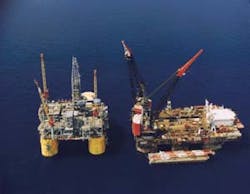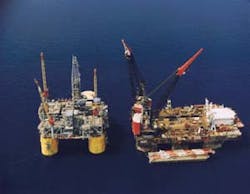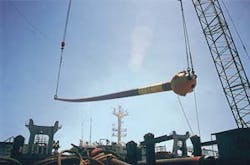Process proves that tendon foundation templates not needed
Positioning the Mars TLP tendons and free-standing piles
Danny Keener
John E. Chance Associates
The SSCV Balder (right) completed the installation of tendons on the Mars TLP without foundation templates used a special positioning process (Photo courtesy of Shell Offshore).Imagine dangling a large pencil from a five story building and hitting a circle on the sidewalk no larger than a quarter. The same kind of accuracy was required to position the tendon piles for the Gulf of Mexico's deepest installation - Shell's Mars tension leg platform (TLP).
The Mars Project required innovative techniques, including a first - the positioning of free-standing piles for tendons which anchor the TLP structure to the seabed. By not requiring tendon foundation templates for tendon installation, the expense of manufacturing and installing templates for each set of tendons was avoided.
The Mars TLP was installed in 2,940 ft water depths in Mississippi Canyon Block 807. The water depth required development of new techniques and products to ensure the precise positioning of both the piles and platform. John E. Chance (Fugro group) undertook the positioning project. Previously, the firm provided positioning and surveying services for Shell's Auger project, which prior to Mars was the Gulf's deepest installation at 2,860 feet. The firm worked with Shell and installation contractors J. Ray McDermott and Heeremac during seven phases of the Mars Field development. Chance developed a set of procedures for each phase.
Tendons for the Shell's Mars TLP are shown being prepared for installation.
Mars program
The Mars Unit blocks encompass all or a portion of six outer continental shelf leases in the Mississippi Canyon area - Blocks 762, 763, 806, 807, 850 and 851. The initial Mars development is designed to recover about 500 million bbl BOE. Production is scheduled to be in the third quarter of this year.
Shell drilled the discovery well in Mississippi Canyon Block 763. After positioning the drillship, the firm also conducted a site investigation on the block. Afterward, positioning for pre-drill installation of 24 guide base assemblies was undertaken, and rig positioning and riser angle monitoring was conducted for the drillship during drilling.
An array of survey benchmark frames, each holding an acoustic transponder, was used during the predrill and installation phases of the Mars project. The acoustic transponders were used to position individual sets of seafloor marker buoys for locating each of the 24 well guide bases. There were four marker buoys for each well guide base. These were used as visual references. In the fourth phase, the firm performed a pipelines hazard survey for the installation of shallow water oil and gas pipelines. One of Chance's permanently mobilized geophysical survey vessels was used for this phase of the project. The fifth phase encompassed the positioning for the shallow water pipelay with J. Ray McDermott as the lead contractor. The firm provided positioning on the lay barge from 20 ft depths in Bay Marchand Block 3 out to about 1,000 ft in Mississippi Canyon Block 407.
The sixth phase - the positioning and surveying for the installation of tendon piles, tendons, and TLP - was contracted through Heeremac and required several types of services. These services included the following:
- Surface positioning of the semisubmersible crane vessel (SSCV) Balder along with its anchor positioning.
- Acoustic positioning for the piles in three dimensions.
- Acoustic positioning for three remotely operated vehicles (ROVs) for buoy positioning and tendon positioning.
- Inclination measurement of the piles.
- Hammer positioning and depth measurement.
- As-installed survey of piles.
Transponder equipment for guidance is shown being installed in preparation for installing the Mars TLP tendons.
Surface positioning
For surface positioning, the firm used Starfix, interfaced to an new system called Tug Nav. The system can manage the tracking of eight tug boats or other remote vessels simultaneously.
In 1995, 48 marker buoys were installed on the seafloor from the Sonat George Richardson, using Chance's acoustic positioning techniques. Once the positions of the marker buoys were verified from the Balder, pile stabbing activities commenced. Twelve piles were installed to a penetration of about 350 ft. Positioning was required for each of the following steps:
- Surface position for the Balder for tendon installation.
- Surface position of the TLP during tendon installation.
- Position and monitoring of tugs during tendon installation.
- Acoustic position of up to four ROVs during tendon installation.
The positioning firm currently is working with J. Ray McDermott on the deepwater J-lay and installation of the 14-in. gas lines and 18-in. oil lines. The J-lay portion includes installation of two subsea completion flow lines and umbilicals.
Hydraulic arid electrical umbilicals are scheduled to be laid from Mars using McDermott's dynamically positioned vessel DB50, with ultra-short baseline acoustics to track and position an ROV monitoring touchdown. The firm will complete the project by doing a survey of the completed pipelines and umbilicals.
The Mars installation proves tendon foundation templates are not required for deepwater TLP installations. These techniques and procedures developed for Mars will be used on future installations.
Copyright 1996 Offshore. All Rights Reserved.


